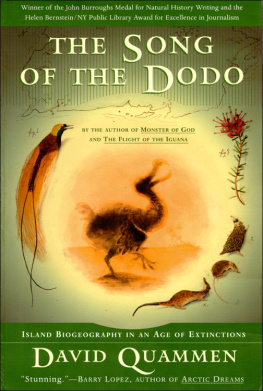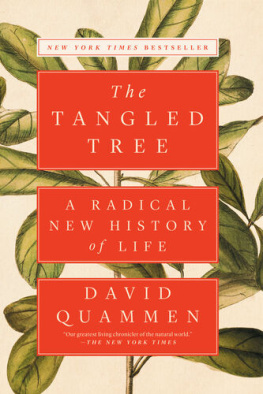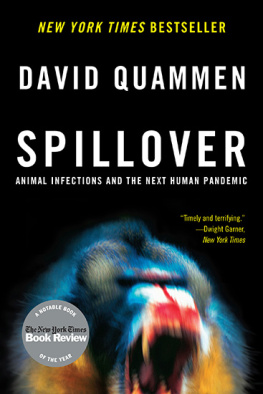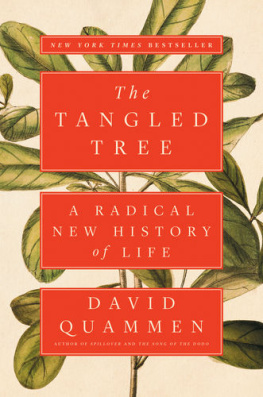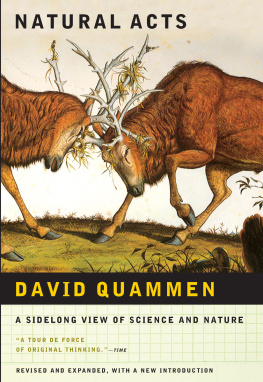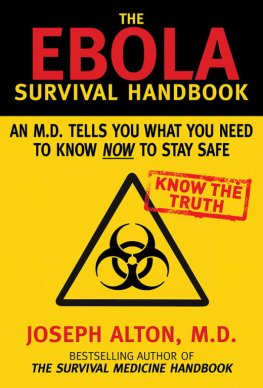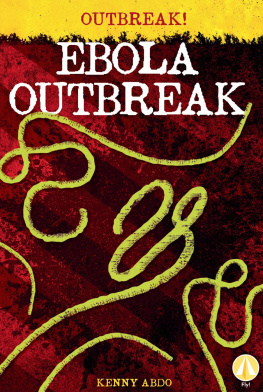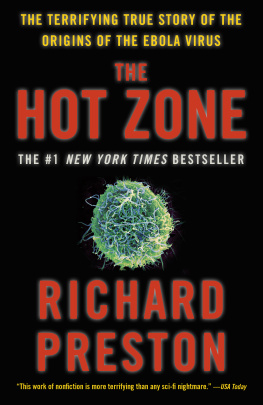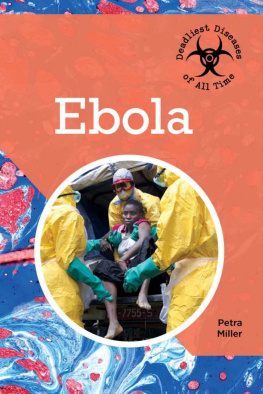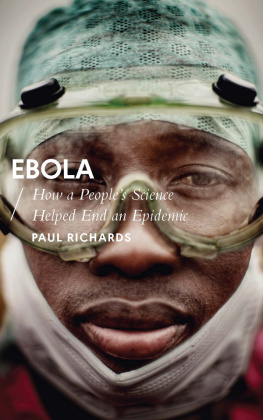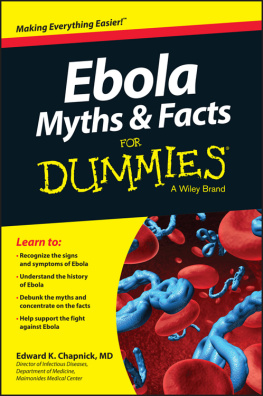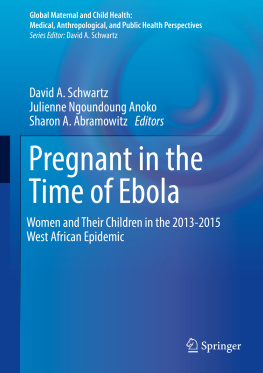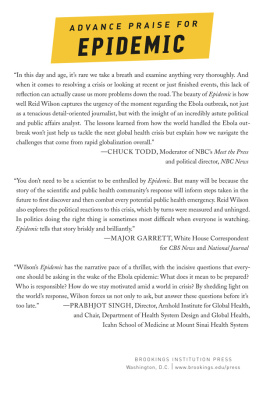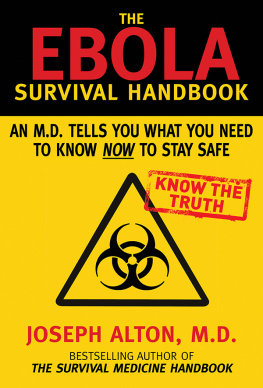Contents
Ebola
The Natural and Human
History of a Deadly Virus
DAVID QUAMMEN
During the spring and summer of 2014, people around the world have watched with concern, appalled fascination, sympathy, and no small amount of personal fear as an outbreak of Ebola virus disease (EVD) has unfolded and spread among three troubled countries in West AfricaGuinea, Liberia, Sierra Leoneand then made a disconcerting leap, by airplane, to Nigeria. Having smoldered for months, killing victims by the dozens, it flamed in August of that year and began stacking up mortalities, week by week, in the hundreds. By then it had become the worst Ebola outbreak in the history of this peculiar, disconcerting disease. The story of the 2014 outbreak was so rivetingly awful that it competed for headline space with contemporaneous events in Syria, Ukraine, and the Gaza Strip.
But an outbreak of Ebola is very different from the dire realities of politics and war: more ineffable, more spooky. Ebola virus is invisible, except through an electron microscope or by way of its pathogenic effects. It is impersonal. It is apolitical. It seems to kill like the tenth plague of Egypt in Exodusthe one inflicted by an angel of death.
This last impression is misleading. Ebola is no death angel; its mystifying but not preternatural. Its just a virusalbeit a virus that, inconspicuous elsewhere, tends to be hellaciously destructive when it gets into a human body.
Every newly emerging infectious disease, EVD included, begins as a mystery story. The mysteries are several. Whats causing the sudden explosion of misery and death? If its a virus, what sort of virus? Has science ever seen anything like it? Where has it come from? Any virus must abide in a living creature, in order to replicate and survive over time, so which creature? And how has it moved from that creature into humans? Can the new virus be controlled? Can it be battled with pharmaceutical therapies or vaccines? Can it be stopped? Or is this outbreak going to be the Next Big One, a catastrophic pandemic, destined to sweep around the world and kill some sizable fraction of the human population, like the Black Death of the fourteenth century or the influenza of 1918? Disease scientists and public health officials are the intrepid investigators, the Sam Spades and Philip Marlowes and Detective Chief Inspector Jane Tennisons, who muster out to address these mysteries. In the case of Ebola, they have solved some but not all.
This little volume, excerpted and adapted from my 2012 book Spillover, with some additional material, is an attempt to place the 2014 West Africa outbreakand a separate independent outbreak, which has recently flared in the Democratic Republic of the Congowithin a broader context that makes sense of those mysteries and their partial solutions. My offering here is merely a partial view of the history and science of Ebola, and a somewhat personal one, which has grown from my own modest travels through Ebola habitat, and from a chance encounter in the forest with two men who had seen the virus at its worst, killing their friends and loved ones. (To be clear: I myself have never had that harrowingly instructive experience, and I have not visited West Africa to observe or report on the current outbreak.) I also include here some treatment of Marburg virus, for two reasons: because it is closely related to Ebola virus, within the filovirus family, and because certain important questions that remain unanswered about Ebola virus have been answered for Marburg, as youll see, suggesting valuable (though guarded) inferences about Ebola itself.
Ebola virus disease has been mostly an African affliction (so far), and although its unique, it is no anomaly. It just represents an especially dramatic version of a global phenomenon.
Everything comes from somewhere, and strange new infectious diseases, emerging abruptly among humans, come mostly from nonhuman animals. The disease might be caused by a virus, or a bacterium, or a protozoan, or some other form of dangerous bug. That bug might live inconspicuously in a kind of rodent, or a bat, or a bird, or a monkey, or an ape. Crossing by some accident from its animal hideaway into its first human victim, it might find hospitable conditions; it might replicate aggressively and abundantly; it might cause illness, even death; and in the meantime, it might pass onward from its first human victim into others. Theres a fancy word for this phenomenon, used by scientists who study infectious diseases from an ecological perspective: zoonosis.
Thats a mildly technical term, unfamiliar to most people, but it helps clarify the biological complexities of swine flu, bird flu, SARS, West Nile fever, emerging diseases in general, and the threat of a global pandemic. It helps us comprehend why medical science and public health campaigns have been able to conquer some fearsome diseases, such as smallpox and polio, but are unable to conquer others, such as dengue and yellow fever. Its a word of the future, destined for heavy use in the twenty-first century. A zoonosis is an animal infection thats transmissible to humans.
Bubonic plague is a zoonosis. All strains of influenza are zoonoses. So are monkeypox, bovine tuberculosis, Lyme disease, Marburg, rabies, Hantavirus Pulmonary Syndrome, and a strange affliction called Nipah, which has killed pigs and pig farmers in Malaysia, as well as people who drink date palm sap (sometimes contaminated with the virus from bat droppings) in Bangladesh. Each of them reflects the action of a pathogen that can cross into people from other species. This form of interspecies leap is common, not rare; about 60 percent of all infectious diseases currently known either cross routinely or have recently crossed between other animals and us. Some of thosenotably rabiesare familiar, widespread, and still horrendously lethal, killing humans by the thousands despite centuries of efforts at coping with their effects, concerted international attempts to eradicate or control them, and a pretty clear scientific understanding of how they work. Others are new and inexplicably sporadic, claiming a few victims or a few hundred in this place or that, and then disappearing for years.
Smallpox, to take one counterexample, is not a zoonosis. Its caused by the variola virus, which under natural conditions infects only humans. That helps explain why a global campaign mounted by the World Health Organization (WHO) to eradicate smallpox was, as of 1980, successful. Smallpox could be eradicated because that virus, lacking the ability to reside and reproduce anywhere but in a human body (or a carefully watched lab animal), couldnt hide.
Zoonotic pathogens can hide. Thats what makes them so interesting, so complicated, and so problematic. These pathogens arent consciously hiding, of course. They reside where they do and transmit as they do because those happenstance options have worked for them in the past, yielding opportunities for survival and reproduction. By the cold Darwinian logic of natural selection, evolution codifies happenstance into strategy.
The least conspicuous strategy of all is to lurk within whats called a reservoir host. A reservoir host is a species that carries the pathogen, harbors it chronically, while suffering little or no illness. When a disease seems to disappear between outbreaks, its causative agent has got to be someplace, yes? Well, maybe it vanished entirely from planet Earthbut probably not. Maybe it died off throughout the region and will only reappear when the winds and the fates bring it back from elsewhere. Or maybe its still lingering nearby, all around, within some reservoir host. A rodent? A bird? A butterfly? A bat? To reside undetected within a reservoir host is probably easiest wherever biological diversity is high and the ecosystem is relatively undisturbed. The converse is also true: Ecological disturbance causes diseases to emerge. Shake a tree, and things fall out. Capture a bat for food, and you might catch something else too. Butcher a chimpanzee, to feed your family or your village, and who knows what grisly surprises might emerge. The event of transmission, when a pathogen passes from one kind of host to another, is called spillover.
Next page

